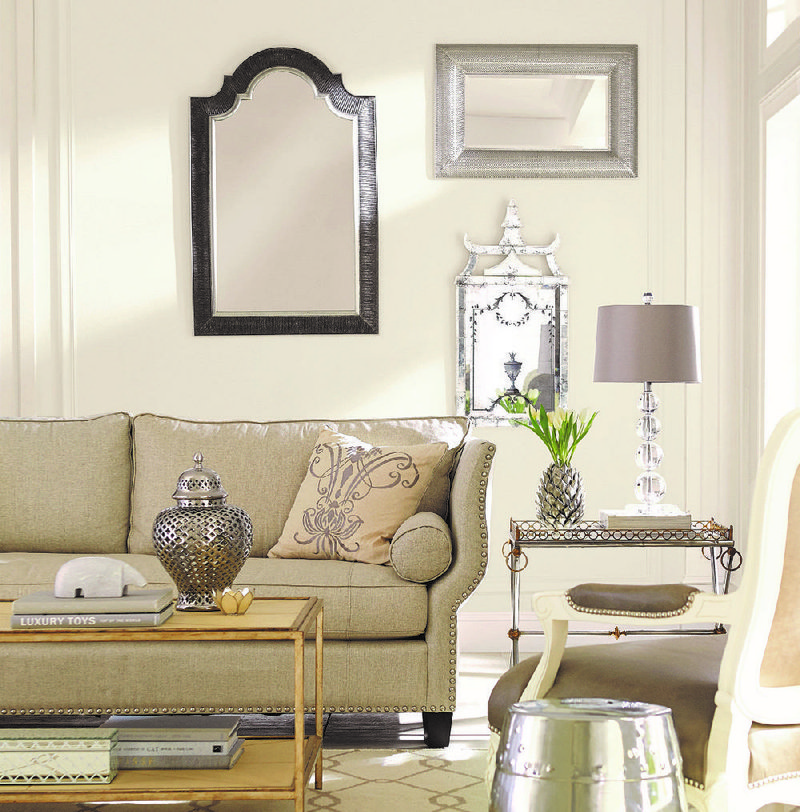"Let's just paint it white," says my daughter Marissa, who is looking at pictures of the one-bedroom condo she will move into next month. The place is over 60 years old, and looks it. The tired tan walls make you feel as if you are walking into a lunch sack.
"Honey," I say, "the words 'just' and 'white' don't belong in the same sentence." She may be going to graduate school, but she has a lot to learn.
Picking a white is hard. Picking a wall color from out of state is foolish. We're doing both. I'm in Orlando, Fla. She's in San Francisco. The condo is in Nashville, Tenn. And the painter is coming in the morning.
Please, don't do this. Choosing a paint color without testing it in the actual space is like getting a mail-order groom, a total crapshoot you're going to have to live with.
"Well, it's not ideal," agrees my friend and colleague Sue Wadden, director of color marketing for Sherwin-Williams. I'd called her to confess, and get a gram of confidence and maybe some direction. "But if you are faced with that as your only option, ..." her words trail off, probably because she can think of nothing encouraging to say.
"White, of course, is never truly white," she starts, causing lessons from my color theory class to the surface like a long-dormant sea creature from the ocean floor. When dealing with color in light form, black is the absence of color, and white is all color. This is why a prism breaks white light into a rainbow. With color pigment, the reverse is true. White is the absence of color, and black is all color. Mix all paint colors together; you get black.
Because you can't have a nothing-color paint, white paint is never truly white. Even base white paint has tints, traces and tones causing it to veer cream, gray, taupe, beige, blue, green, peach, and on into infinity. This makes me want to lie down in a lightless room.
"And all whites are definitely not created equal," Wadden says.
As we talk, I swirl open my Sherwin-Williams fan deck to the section called "White & Pastel."
"Divine White, Marshmallow, Crisp Linen, there are hundreds of whites here," I say.
"Ninety-four," she says. "It's our most popular color category. Partly because you hear homeowners say, 'I have no idea what color to paint,' so they choose..."
"... just white," we say in unison.
However, many good reasons exist to choose white intentionally.
"Clean, bright and often dramatic, the right white works in many spaces," Wadden says.
White can open up a small room, and lighten a dark one. For minimalists and modernists, white is the perfect dramatic backdrop when the focus is on line. Monochromatic rooms that layer shades and textures of white look elegant. White walls in rooms that have a lot of color and pattern, say ones with a Bohemian gypsy vibe, help showcase the decor.
White can also minimize architectural weaknesses. If your white baseboards and trim are underwhelming, painting walls a shade of white will downplay them.
Marissa and I trade inspirational photos of white rooms and share paint color suggestions. We zero in on four whites, shades just whispers apart. As I'm painting sample boards, the painter texts: "Did you pick your wall color yet?"
I'm starting to panic. "Getting close!" I text back with a snapshot of my test boards. "I'll tell you in the morning."
"Lol," he texts. "Good luck with that."
If you, too, are sold on white, here's how Wadden suggests you pull one from the lineup:
Find your undertone. Just a trace amount of undertone will change the whole space, says Wadden, who puts whites into three buckets: cool, warm, and something in between. Cool whites have a hint of lilac, blue, gray or green. "There is a little chill in the color." Warm whites have a touch of yellow, beige or blush. Neutral whites, sometimes called "white done right," she equates to canvas or bone. "Neutrals often hit the sweet spot. Not too cool, not too warm."
Consider your environment. When deciding which category of white you want, consider the feeling you want in the room and where it is. "In Boston, you'll probably want a warmer, creamy white," she said. A cool white will feel too icy. Also factor in your floors; a cool gray carpet will fight with warm white walls, although a neutral white could work.
Get swatches. View paint chips in the actual space -- ahem, ideally. Online visualization tools, where you upload a photo of your room and test drive wall colors, may help when deciding between yellow or blue, but are less helpful when comparing shades of one color, partly because monitor colors vary.
Paint samples. Get test quarts of your final contestants and paint a larger sample on pieces of drywall or cardboard to see more volume of the actual paint. (The color on the sample chip is lacquer.) I used Small Wall (www.mysmallwall.com), 12-by-12-inch re-paintable sample boards that you can stick to your wall, like poster-board Post-it Notes. View colors in different lights.
Don't color match. Once you've gone to the trouble to dial in your color, don't buy it from another company. Every paint store will offer to color match a competitor's color, but each company has its own pigments, so the color you end up with can be slightly off. Get the paint from the original maker.
The next morning, after a restless night, I tell the painter to go with Oyster White (SW7637) in living areas, and Alabaster (SW 7008) in the bathroom and kitchen.
"Did you pick a color?" Marissa texts.
"Yes," I say, "Imperfectly White."
Syndicated columnist Marni Jameson is the author of three home and lifestyle books, including Downsizing the Family Home -- What to Save, What to Let Go (Sterling Publishing 2016). You can reach her at www.marnijameson.com.
HomeStyle on 07/28/2018

